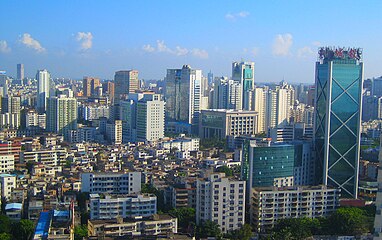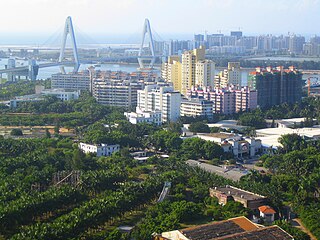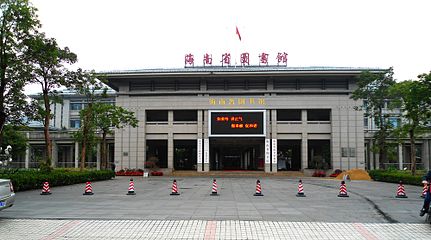Haikou
Haikou
海口市 Hoihow | |
|---|---|
| City of Haikou | |
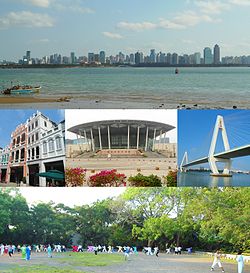 Top: Panoramic view of Haikou from Xixiu Beach, Middle from left: A facade building in Zhongshan Road in Qiongshan District, Hainan Performance of Art Center, Haikou Century Bridge and Nandu River, Bottom: Haikou People's Park in Lonhua District | |
| Nickname: Coconut City (椰城) | |
 | |
 Location of Haikou City jurisdiction in Hainan | |
| Coordinates (Hainan People's Government): 20°01′07″N 110°20′56″E / 20.0186°N 110.3488°E | |
| Country | China |
| Province | Hainan |
| Government | |
| • Type | Prefecture-level city |
| • Body | Haikou Municipal People's Congress |
| • CCP Committee Secretary | Ding Hui Acting |
| • Congress Chairman | Han Yingwei |
| • Mayor | Ding Hui |
| • CPPCC Chairman | Guo Yanhong |
| Area | |
| 2,237 km2 (864 sq mi) | |
| • Urban (2018)[1] | 427 km2 (165 sq mi) |
| • Metro | 2,280 km2 (880 sq mi) |
| Population (2020 Census)[2] | |
| 3,001,600 | |
| • Density | 1,300/km2 (3,500/sq mi) |
| • Urban (2018)[3] | 2,250,000 |
| • Urban density | 5,300/km2 (14,000/sq mi) |
| • Metro | 2,046,189 |
| • Metro density | 900/km2 (2,300/sq mi) |
| GDP[4] | |
| • Prefecture-level city | CN¥ 235.8 billion US$ 33.4 billion |
| • Per capita | CN¥ 80,837 US$ 11,408 |
| Time zone | UTC+08:00 (China Standard) |
| Postal code | 570000 |
| Area code | 898 |
| ISO 3166 code | CN-HI-01 |
| Website | haikou.gov.cn |
| Haikou | |||||||||||||||||
|---|---|---|---|---|---|---|---|---|---|---|---|---|---|---|---|---|---|
 "Haikou", as written in Chinese | |||||||||||||||||
| Chinese | 海口 | ||||||||||||||||
| Postal | Hoihow | ||||||||||||||||
| Literal meaning | Mouth of the sea | ||||||||||||||||
| |||||||||||||||||
Haikou[a] is the capital and most populous city of the Chinese province of Hainan.[6] Haikou city is situated on the northern coast of Hainan, by the mouth of the Nandu River. The northern part of the city is on the Haidian Island, which is separated from the main part of Haikou by the Haidian River, a branch of the Nandu. Administratively, Haikou is a prefecture-level city, comprising four districts, and covering 2,280 square kilometres (880 sq mi). There are 2,046,189 inhabitants in the built-up area, all living within the four urban districts of the city.[7]
Haikou was originally a port city, serving as the port for Qiongshan. During the Chinese Civil War, Haikou was one of the last Nationalist strongholds to be taken by the Communists — with the Battle of Hainan Island in 1950. Currently, more than half of the island's total trade still goes through Haikou's ports. The Temple of the Five Lords is located to the southeast of the city.
The city is home to Hainan University, a comprehensive research university under the Project 211 and the Double First Class University Plan in certain disciplines,[8] which has its main campus on Haidian Island.
History
[edit]The hanzi characters comprising the city's name, 海口, mean ocean/sea and mouth/port, respectively. Thus, the name "Haikou" is also a word for "seaport" – similar to Portsmouth in Britain.[citation needed] Haikou originally served as the port for Qiongshan, the ancient administrative capital of Hainan island, located some 5 km (3.1 mi) inland to the south east. During its early history Haikou was a part of Guangdong province. In the 13th century it was fortified and became a military post under the Ming dynasty (1368–1644). The port is located west of the mouth of the Nandu River, Hainan's principal river. When Qiongshan was opened to foreign trade under the Treaty of Tianjin in 1858, Haikou started to rival the old administrative city. It was formerly known internationally as 'Hoihow', based on the Cantonese pronunciation by the British Raj officers. In 1926, Haikou overtook Qiongshan in population and it was declared a separate administrative city.
The city and island of Hainan stayed under the control of the Nationalists until April 1950, when it fell to the Communists during the Landing Operation on Hainan Island.
Since 1949, Haikou has maintained its position as Hainan's main port, handling more than half of the island's total trade. It has replaced Qiongshan as the island's administrative capital. In 1988, Haikou was made a prefecture-level city as well as the capital of the newly created Hainan Province.
Haikou old town contains a small portion of the oldest buildings in Haikou city that returnees from overseas built. The houses are a mixture of styles including Portuguese, French, and Southeast Asian. The streets used to be divided into different areas selling Chinese and western medicine, for silk and bespoke clothes, one for fresh fish and meat, and others for the sale of incense, candles, paper, ink, and other goods.
Various projects are currently under discussion to decide the best way to restore and preserve these historical buildings.[citation needed]
Geography
[edit]
Haikou is situated on the north coast of Hainan Island, by Haikou Bay, facing the Leizhou Peninsula across the Qiongzhou Strait that stretches west from Beibu Bay near Vietnam to the James Shoal bordering the South China Sea to the west. Most of the city is almost completely flat and only a few metres above sea level. It has an area of 2,304.84 km2 (889.90 sq mi).[citation needed][9] The Meishe River winds through the east side of the city flowing northward to the Haidian River.
The northern part of Haikou City, the district of Haidian Island, is separated from the main part of Haikou by the Haidian River, a tributary of the Nandu River. The district is accessed by one of four bridges, the largest being Haikou Century Bridge, which connects the Guomao district with Haidian Island at the estuary of the Haidian River. From east to west the remaining three road connections are provided by the Renmin, Heping and Xinbu Bridges.
Directly to the northeast of Haikou and to the east of Haidian Island is Xinbu Island.
Climate
[edit]Haikou is on the northern tropical zone, and is part of the Intertropical Convergence Zone. April to October is the active period for tropical storms and typhoons, most of which occur between August and September. May to October is the rainy season with the heaviest rainfall occurring in September. The city has a tropical wet and dry climate (Köppen Aw). Extremes since 1951 have ranged from 2.8 °C (37 °F) on 12 January 1955 to 41.3 °C (106 °F) on 30 April 2024.
| Climate data for Haikou (1991–2020 normals, extremes 1951–present) | |||||||||||||
|---|---|---|---|---|---|---|---|---|---|---|---|---|---|
| Month | Jan | Feb | Mar | Apr | May | Jun | Jul | Aug | Sep | Oct | Nov | Dec | Year |
| Record high °C (°F) | 33.5 (92.3) |
37.2 (99.0) |
38.1 (100.6) |
41.3 (106.3) |
39.2 (102.6) |
38.4 (101.1) |
38.7 (101.7) |
37.3 (99.1) |
36 (97) |
34.5 (94.1) |
34.7 (94.5) |
31.5 (88.7) |
41.3 (106.3) |
| Mean daily maximum °C (°F) | 21.3 (70.3) |
23.0 (73.4) |
26.6 (79.9) |
30.2 (86.4) |
32.5 (90.5) |
33.6 (92.5) |
33.4 (92.1) |
32.5 (90.5) |
31.1 (88.0) |
28.9 (84.0) |
26.1 (79.0) |
22.4 (72.3) |
28.5 (83.2) |
| Daily mean °C (°F) | 18.2 (64.8) |
19.3 (66.7) |
22.4 (72.3) |
25.6 (78.1) |
27.9 (82.2) |
28.9 (84.0) |
28.9 (84.0) |
28.3 (82.9) |
27.6 (81.7) |
25.9 (78.6) |
23.2 (73.8) |
19.6 (67.3) |
24.7 (76.4) |
| Mean daily minimum °C (°F) | 16.1 (61.0) |
17.1 (62.8) |
19.9 (67.8) |
22.9 (73.2) |
25.0 (77.0) |
25.9 (78.6) |
25.8 (78.4) |
25.6 (78.1) |
25.0 (77.0) |
23.5 (74.3) |
21.1 (70.0) |
17.7 (63.9) |
22.1 (71.8) |
| Record low °C (°F) | 2.8 (37.0) |
6.5 (43.7) |
6.4 (43.5) |
9.8 (49.6) |
16.3 (61.3) |
21.2 (70.2) |
21 (70) |
21.7 (71.1) |
17.5 (63.5) |
14.1 (57.4) |
10 (50) |
5.3 (41.5) |
2.8 (37.0) |
| Average precipitation mm (inches) | 23.5 (0.93) |
29.9 (1.18) |
42.9 (1.69) |
80.0 (3.15) |
191.4 (7.54) |
238.9 (9.41) |
247.6 (9.75) |
293.0 (11.54) |
268.8 (10.58) |
274.1 (10.79) |
59.6 (2.35) |
38.3 (1.51) |
1,788 (70.42) |
| Average precipitation days (≥ 0.1 mm) | 8.6 | 9.1 | 9.6 | 10.3 | 15.2 | 16.5 | 16.3 | 15.6 | 14.1 | 11.4 | 8.4 | 8.3 | 143.4 |
| Average relative humidity (%) | 85 | 86 | 84 | 82 | 81 | 80 | 80 | 82 | 82 | 79 | 80 | 80 | 82 |
| Mean monthly sunshine hours | 91.5 | 97.0 | 128.5 | 160.4 | 208.5 | 211.7 | 230.6 | 210.0 | 174.5 | 165.7 | 121.0 | 95.5 | 1,894.9 |
| Percent possible sunshine | 27 | 30 | 34 | 42 | 51 | 53 | 57 | 53 | 48 | 46 | 36 | 28 | 42 |
| Source: China Meteorological Administration[10][11][12][13] all-time extreme temperature[14] | |||||||||||||
Environment
[edit]As of 2018[update], Haikou has the second best air quality among major cities nationally, preceded only by Lhasa, Tibet.[15][16] However, since approximately 2009, due to an increase in the number of automobiles, there has been somewhat worsening air pollution.
According to the 2005 statistical book issued by the National Bureau of Statistics, Haikou scored the highest among China's main cities in air quality, with 366 days (2004) of ambient air quality equal to or above grade II, with only 0.033 milligrams/m2 of particulate matter (the least of all main cities), 0.003 milligrams/m2 of sulphur dioxide (only Lhasa had less), and 0.013 milligrams/m2 of nitrogen dioxide (the least of all main cities).[17]
In 1995, the Haikou city government began an initiative to improve the quality of life for its residents. With the approval of the World Health Organization, and Ministry of Health, a ten-point plan was undertaken to address such issues as:
- Community health care
- Vaccinations for children
- Waste recycling
- Green belts and urban trees
- Environmentally friendly construction
- Public toilets (These are available throughout the city, are staffed, and well maintained.)
- Sewage treatment
- Communications
- Noise pollution
The groundwater is of international standard[clarification needed], and is classified as mineral water.
By 2004, the city had established 43 new community health service centers reaching 85 percent of the population. The initiative has increased the size of Haikou's green spaces to 2,000 hectares, with trees lining 40 percent of its roads. Noise pollution has dropped from 61.1db to 58.2db and 300 public toilets have been built. All industrial effluents, industrial waste water and solid waste, and all live sewage, is now processed through centralized treatment centers, and is disposed of without environmental impact. These improvements and others have increased life expectancy in Haikou to 78.26 years.[18]
Haikou city has also built 163 model ecological villages. Now, over 200,000 villagers in 933 villages have tap water in their homes.
Comprehensive city-improvement campaign
[edit]During 2015 and 2016, large-scale city improvements have taken place as part of a province-wide initiative called "double create" (双创). It is described by government sources as a campaign to create a cleaner city and create a more civilized city. It is focused on traffic and commerce, but has also improved the overall appearance of the city, tackling air pollution from industry emissions, aiming to ensure the safety of drinking water sources, improving public security in such places as hospitals, schools, malls, and visitor attractions.[19][20][21] Details of these improvements include:
- Traffic: Many new street crossings with traffic lights were installed around the city to improve two-wheel vehicles (consisting mainly of electric motorbikes) and pedestrian travel. Throughout the city, teams of police have been stationed at major intersections to ensure that two-wheel vehicles obey the law. Although there are many side lanes for these bikes, the actual pedestrian sidewalks serve as legal, one-way routes. Police at intersections stop vehicles either going the wrong way, or running red lights and the offenders may be forced to wear a red sash, stop other offenders, and lecture them.
- Commerce: Around August 2015, teams of officers physically removed nearly all illegal structures used for business in the city (a province-wide campaign) which were commonly made of corrugated metal or cinderblocks and were shop extensions or simply unused space that had been built upon. Street vendors were banned (most of whom sold vegetables or fruit), as was the night operation of roadside BBQ sites and the placement of tables onto the sidewalks by restaurants. These night time food operations were once common throughout the city.
- Roads and sidewalks: Many small roads have been repaved including narrow lanes in old neighbourhoods. Also, many sidewalks have been upgraded with new brick. Bricks are used as sidewalk material in Haikou because of the large amount of ficus trees, the roots of which deform the surrounding sidewalk.
- Demolition and reconstruction: A number of entire neighbourhoods within the city have been, and are being, entirely demolished with new buildings and roads being built.
- Starting around the beginning of 2018, the city government funded painting and cladding of a number of buildings in the city centre.
Water and sewage treatment
[edit]The treatment of Haikou's wastewater, and the supply of tap water is operated by the French company Veolia Water. The partial privatization agreement gives 49 percent ownership to Veolia Water in a 30-year joint venture with Haikou Water Group (2012–2042).[22][23][24][25]
Demographics
[edit]According to the 2010 Census, the prefecture-level city of Haikou has a registered population of 2,046,189 inhabitants, 537,848 more than the population declared on the past census in 2000.[7] The average annual population growth during the period 2000–2010 was of 3.1 percent.[26] Most of the population of Haikou are Han Chinese (around 97.75 percent, according to the 2010 Census).
Subdivisions
[edit]Districts
[edit]Haikou is divided in four districts. The information presented here uses 2010 Census data.
| Map | |||||
|---|---|---|---|---|---|
| District | Simplified Chinese | Hanyu Pinyin | Area (km2) | Population (2010) |
Density (/km2) |
| Longhua | 龙华区 | Lónghuá Qū | 275 | 593,018 | 2,156 |
| Xiuying | 秀英区 | Xiùyīng Qū | 512 | 349,544 | 683 |
| Qiongshan | 琼山区 | Qióngshān Qū | 940 | 479,960 | 511 |
| Meilan | 美兰区 | Měilán Qū | 553 | 623,667 | 1128 |
Neighbourhoods
[edit]There are several distinct neighborhoods within the city, including:
Guomao
[edit]Guomao is a relatively affluent area located on the coast between Longquan Road to the east running west for more than one kilometre. The west part of this area has experienced substantial development since about 2007, and now contains dozens of newly built high-rise residential apartment buildings.
Bo'ai Road
[edit]

This historical area is located on the south side of the Haidian River, at the northern part of mainland Haikou. Much of the area comprises arcade style, dilapidated buildings with European fusion-type architectural facades with Indian and Arabic influences.[27] The buildings are almost all painted white, and are usually no more than a few storeys tall. The eastern part of the area is mainly residential. The western part contains hubs for such items as exotic foods, pets, and fabrics. The building facades and roads have been restored in most of the area, Zhongshan Road being the most notable.
Hainan University area
[edit]Located on Haidian Island, this area comprises the entire portion of the island west of its main north–south road, Renmin Dadao. It appears similar to a typical student ghetto, containing many small, inexpensive food stands and restaurants.
Haikou West Coast
[edit]A new neighbourhood is under development in Xiuying District around seven km west of downtown Haikou. Located within the neighbourhood are Hainan International Convention And Exhibition Center, Wuyuan River Stadium and Hainan Science and Technology Museum (expected to be completed in 2025). Also, a number of government offices have moved there and numerous residential apartment complexes are being built.
Parks and recreational areas
[edit]
- Evergreen Park is a 71.3 hectare[28] park located on Binhai Road about 200 m west of the southern foot of Haikou Century Bridge. It is the largest park in Haikou, containing approximately ten thousand coconut trees and several hundred species of South Asian ornamental plants,[28] however, most of the park consists of grassy fields.
- Baishamen Park (White Sand Gate Park) was created in 2010 and is located on the north shore of Haidian Island. The park contains a small amusement park, and consists mostly of grass fields, with little tree cover.
- Changying Global 100 Fantasty Park is an under-construction amusement park around 12 km west of downtown Haikou.
- Golden Bull Mountain Ridge Park (Jinniuling Park) includes a small zoo, a lake, diverse flora, and a high percentage of forest areas, including a large bamboo forest. It is located on Haixiu Road, west of Longquan Road, the main north–south avenue in Haikou.
- Binhai Park is located east of Evergreen Park. There is a bougainvillea hybrid exhibition held each year. This park has a small lake and building used for community purposes in the middle.
- Haikou People's Park is a recently refurbished park located in the downtown area on Haixiu Road next to East Lake.[29] The park draws large numbers of people each morning who engage in exercises, predominantly tai chi, fitness dancing, and aerobics.
- Hainan International Friendship Park is planned to occupy 180,000 square metres (1,900,000 sq ft) of land, with a length of over 2,000 metres (6,600 ft).[30]
- Hongcheng Lake (红城湖) is one of the largest water bodies in the city being around equal in size to the lake at Golden Bull Mountain Ridge Park. It has three islands, the largest of which contains a defunct hotel. The lake is a popular location for fishermen. At night, hawker stalls are set up along the roadsides for tourists and locals to drink and dine.
- Holiday Beach is a 7 kilometres (4.3 miles)-long beach and visitor attraction adjacent to the west side of Haikou.
- Dongzhai Port Nature Reserve lies some 15 kilometres (9.3 mi) south east of Haikou and was the first protected mangrove forest zone in China.
- Meishe River National Wetland Park, an eco-park located on the Meishe River
Other notable locations
[edit]- Zhongjie Road (忠介路), a shopping street with a long history
- Jiefang East Road, a busy shopping street located west of the Bo'ai Road area
- Guoxing Avenue, a main east–west street with many notable buildings
- The Haikou Tower is an under-construction supertall skyscraper. Located on Guoxing Avenue at Haifu Road, it will be 94-storeys, and is scheduled for completion between 2020 and 2023.
Economy
[edit]
The GDP per capita was US$3,573 in 2008, ranked number 43 among 659 Chinese cities. In 2011, the city's GDP reached 71.3 billion yuan, amounting to about 30 percent of the province's total.[31]
Haikou exports substantial quantities of agricultural produce and livestock.[citation needed] There is a small amount of industry, including canning, textiles, rice hulling, and light engineering.
The "International Tourism and Central Business District" is under construction on the west part of Guoxing Avenue. The road was once only home to government buildings. Starting around 2011, HNA and other groups began erecting office buildings. Also located at the western end of Guoxing is the HNA Building, the headquarters of Hainan Airlines.[32]
Near the southern end of Haikou, automotive manufacturer Haima Automobile has its global headquarters.
The Haikou Free Trade Zone (Haikou FTZ) (海口保税区) is a state-level, 1.93 km2 area located between Nanhai Road and Yehai Road. It was approved on October 21, 1992, by the State Council.[33]
Education
[edit]
Several major educational institutions are located in Haikou:
- Hainan University has its main campus on Haikou's Haidian Island, with the South China Tropical Agricultural University, now part of the university, located in the southern part of the city.
- Hainan Normal University is the oldest institution for higher learning, with a new campus in Guilinyang. It has an enrolment of more than 20,000, including approximately 200 foreigner students.
- Hainan Medical College, founded in 1993, offers degrees in medicine. It is located in the southern part of the city.
- Qiongtai Normal University is located in Qiongshan District, with a new campus in Guilinyang.
- Haikou College of Economics, located by Guoxing Avenue, with a new campus in Guilinyang.
- Chinese Academy of Tropical Agricultural Sciences is located across the road from Hainan Medical College.
- Hainan Middle School
Transportation
[edit]
- Main transportation hubs in Haikou:
- A: Haikou Port New Seaport area
- B: South Port
- C: Haikou Railway Station
- D: Haikou Port Xiuying Port area
- E: Haikou New Port
- F: Haikou Transportation Center (main bus station)
- G: Haikou East Railway Station
- H: Haikou Meilan International Airport
Urban
[edit]Haikou has an extensive urban bus service. Standard fare is 1 yuan, with no bus pass, ticket, or transfer system in place. Urban minibuses operated prior to 2009, but have since been phased-out. Taxi automobiles and electric motorbikes operate throughout the city. During 2009–2010, petrol-fueled motorbike taxis were banned and seized by police at numerous checkpoints within the city.
Haikou has experienced a substantial increase in cars since the early 2000s. Traffic on main streets, once light, is now similar to other major cities, with rush hour problems that have prompted the city to expand several main roads and build a new elevated road from the west end of Guoxing Avenue to new developments west of Holiday Beach.
Many main roads in the city have a side lane, separated by a median, for two-wheeled vehicles.
Physical barriers were installed on many of the main two-way streets throughout the city in order to separate opposing lanes. These were installed for safety reasons to prevent pedestrians from crossing the streets at locations other than intersections.
Roundabouts are not prevalent in Haikou, being used mainly on Hai Xiu road, and a few other locations.
Traffic cameras are used at many main intersections in the city, with tickets being issued by post for traffic light infractions.
There is one tunnel in the city, the Qiaozhong Road Tunnel.
Shared bicycles
[edit]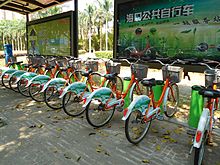
The Haikou Public Bicycle System has about 20,000 bicycles. A pre-paid swipe card system is used to gain access to them. Starting on January 24, 2017, privately run app-based "dockless" shared bikes came into service. By April, there were about 40,000 of these types of bikes available.[34] Ofo, Mobike, and "Quick to" all cost 2 RMB per hour. Ofo and "Quick to" bikes have tires with tubes, meaning many are left around the city with flat tires. The Haikou Public Bicycle System has installed a number of new, more modern bikes with tires that cannot be punctured. Part of Mobike's fleet also uses these types of tires.
Air
[edit]Haikou is served by Haikou Meilan International Airport (IATA: HAK, ICAO: ZJHK[1]), which is located 25 km (16 mi) from the city.
In January 2011, Haikou was selected to be the first test site for an experiment allowing private helicopter flight in China.[35]
Rail
[edit]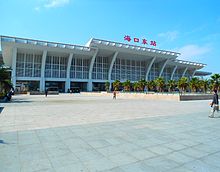
A railway links Haikou to the mainland. A ferry service transports the railway cars, along with other motor vehicles across the strait.
The Hainan East Ring Railway links Haikou and Sanya. There are 15 stations in between, either in operation or still under construction. Trains are designed to travel at 250 km/h (155 mph). Travel time from Haikou to Sanya is approximately 1 hour and 22 minutes. The main station in Haikou is Haikou East railway station located near the southern end of Long Quan Road. In 2018, the Haikou South Station, the main bus station, relocated and is now directly to the south east of the Haikou East Railway Station.
In 2015, the Hainan western ring high-speed railway started operation. This second high-speed railway runs along the west coast of Hainan connecting with the Hainan Eastern Ring Railway.
Starting July 1, 2019, the Haikou Suburban Trains began operation. Up to 7 CRH6F-A (CRH6F with only 4 carriages) trains with specially-designed liveries will operate between Haikou station and Meilan station. The longest distance it will travel one-way is around 38 kilometers with 4 stations in between.[36]
Road
[edit]Three main highways connect Haikou to other parts of Hainan, running east, west, and south through the middle of the province. The Haiwen expressway connects the city with Wenchang to the southeast. The main bus station is Haikou Transportation Center, located beside Haikou East railway station.
Seaports
[edit]
Haikou has four seaports for passenger and cargo service. Haikou New Port, formerly known as the Inner Harbour, is located on the southern side of the mouth of the Haidian River. Approximately 7 km (4 mi) west of Haikou New Port is Haikou Xiuying Port. This port is considerably larger, and is the main distribution centre for cargo entering Hainan. It is also a major port for immigration onto Hainan Island. Around 20 km (12 mi) west of downtown Haikou are South Port and Haikou Port New Seaport.
Arts and culture
[edit]
Several large public buildings now occupy Guoxing Avenue, the new area for arts and culture. These include the Hainan Provincial Museum, the Hainan Provincial Library, and the Hainan Centre for the Performing Arts. These are all located near to one another on the south side of the road, west of Haikou College of Economics, Haikou campus.
At the west side of Evergreen Park is the Haikou Great Hall of the People, a concert hall, and Hainan Exhibition & Convention Center, a large centre for trade shows and other commercial events. Haikou City Stadium, is the main venue for sports events, and is located at the southeast corner of Evergreen Park.

The Wuyuan River Stadium opened in April 2018. It is located west of downtown Haikou, near the newly built Haikou West Coast. With a capacity of over 40,000, it is the largest stadium in the province.
Older cultural sites include the now-restored buildings of the Bo'ai Road area, the tomb of Hai Rui, Xiuying Fort in the Guomao area, the Temple of the Five Lords, the cemetery for the martyrs of Hainan's Battle of the Liberation, and the former temple Haikou Yazhou Gu Cheng.
Nightlife
[edit]Bars and KTV are patronized until after midnight. There are several popular bar streets within the city. Up until 2015, roadside BBQ sites were common throughout the city. A large-scale campaign to clean up the city has since prohibited them.
Tourism
[edit]Also known as the "Coconut city", Haikou is an important tourist destination for China.[37] The city received 4.11 million tourists in 2002, up 7.99 percent from 2001. In 2019, the number of tourists in Haikou has exceeded 83.11 million. The city earned approximately three billion yuan (361 million US dollars) from the tourism industry during that period, up 11 percent from the previous year.[38]
Haikou is also developing its Meetings, Incentives, Conferencing, Exhibitions industry. The local government set up the Haikou Convention and Exhibition Bureau in June 2012 and pledged RMB35 million (US$5.6 million) to support the development of the MICE industry.[39] More international hotel chains are also arriving. By 2013, international brands included Shangri-La, Westin (opening September 2013[40]), and Sheraton.
In 2016, the China Merchants holdings group unveiled its plans to develop Shenzhen, Haikou and Sanya as the three destination ports that its South China Sea passenger cruises would serve. Subsequently, a large passenger cruise terminal was inaugurated in Shenzhen in October 2016.[41]
Sister cities
[edit]Haikou has international relationships with these places:[42]
| Cities | Country |
Date of Establishing Sisterhood Relationship |
|---|---|---|
| Darwin | Australia | September 5, 1990 |
| Perth | United Kingdom | February 3, 1992 |
| Saint Nazaire | France | June 27, 1992 |
| Oklahoma City | United States | November 20, 1992 |
| Zanzibar City | Tanzania | October 30, 1997 |
| Gdynia | Poland | April 24, 2006 |
| Victoria | Seychelles | July 25, 2007 |
| Yangon | Myanmar | June 16, 2017 |
| North Lombok Regency | Indonesia | |
| Scottsdale | United States |
Gallery
[edit]-
A view south from Binhai road
-
A view east from Evergreen Park area
-
The customs building
-
A view of Century Bridge from Haidian Island at Night
See also
[edit]Notes
[edit]References
[edit]- ^ Cox, W (2018). Demographia World Urban Areas. 14th Annual Edition (PDF). St. Louis: Demographia. p. 22.
- ^ 海南省统计局 海南省第七次全国人口普查领导小组办公室. "海南省第七次全国人口普查公报(第二号)". 海南省统计局. Retrieved 2023-01-01.
- ^ Cox, W (2018). Demographia World Urban Areas. 14th Annual Edition (PDF). St. Louis: Demographia. p. 22.
- ^ 海南省统计局、国家统计局海南调查总队 (November 2022). 《海南统计年鉴-2022》. 中国统计出版社. ISBN 978-7-5037-7838-4. Retrieved 2023-03-19.
- ^ "Haikou". Lexico UK English Dictionary. Oxford University Press. Archived from the original on May 19, 2021.
- ^ "Illuminating China's Provinces, Municipalities and Autonomous Regions". PRC Central Government Official Website. Retrieved 2014-05-17.
- ^ a b 海口市2010第六次人口普查主要数据公报. Haikou People's Government (in Chinese). Haikou Municipal Bureau of Statistics. 11 May 2011. Archived from the original on 26 January 2021. Retrieved 23 July 2015.
- ^ 教育部 财政部 国家发展改革委 关于公布世界一流大学和一流学科建设高校及建设 学科名单的通知 [Notice from the Ministry of Education and other national governmental departments announcing the list of double first class universities and disciplines] (in Chinese). Ministry of Education of the People's Republic of China.
- ^ "Geography of Haikou" (in Chinese). Official website of Haikou government. 2008-04-01. Archived from the original on 2009-02-06. Retrieved 2008-06-11.
- ^ 中国气象数据网 - WeatherBk Data (in Chinese (China)). China Meteorological Administration. Retrieved 2020-04-15.
- ^ "无标题文档". Archived from the original on 2014-07-10. Retrieved 2020-04-22.
- ^ CMA台站气候标准值(1991-2020) (in Chinese). China Meteorological Administration. Retrieved 2023-04-11.
- ^ 中国地面国际交换站气候标准值月值数据集(1971-2000年). China Meteorological Administration. Archived from the original on 2013-09-21. Retrieved 2010-05-25.
- ^ "Extreme Temperatures Around the World". Retrieved 2013-02-21.
- ^ "China reports better air quality in July".
- ^ Hong, Lin; Thai, Michael. "Fuzhou ranks third in air quality across the nation". chinadaily.com.cn. ChinaDaily. Retrieved 2014-06-18.
- ^ "Ambient Air Quality in Main Cities (2004) in China Statistics 2005". Retrieved 2010-06-27.
- ^ "Haikou's Healthy New Environment". China.org.cn. 2004-08-27. Retrieved 2010-10-18.
- ^ -- 海南省人民政府网. www.hainan.gov.cn (in Simplified Chinese).
- ^ "海口市"双创"工作动员大会--人民网海南视窗--人民网". Archived from the original on 2015-09-30. Retrieved 2015-09-29.
- ^ 冉苗俊. 为海口“双创”从啃硬骨头下手点赞__海南新闻网_南海网. www.hinews.cn (in Simplified Chinese).
- ^ 海口威立雅水务. Haikouvw.com. Archived from the original on 2012-04-26. Retrieved 2011-12-27.
- ^ "Veolia's big bid for Haikou Water | Global Water Intelligence – Archive: Global Water Intelligence". Globalwaterintel.com. Retrieved 2011-12-27.
- ^ "Haikou City No. 1 Water Affairs Company Limited – Individual Project Information – Private Infrastructure Projects – The World Bank & PPIAF". Ppi.worldbank.org. Retrieved 2011-12-27.
- ^ 威立雅水務(海口)投資有限公司注册信息|Veolia Water (Haikou) Investment Co. Limited registered information (in Chinese). Hkcopinfo.com. Archived from the original on 2012-04-26. Retrieved 2011-12-27.
- ^ (in Chinese) Compilation by LianXin website. Data from the Sixth National Population Census of the People's Republic of China Archived 2012-03-25 at the Wayback Machine
- ^ "Qilou Arcade Streets in Haikou, China's Hainan". Usa.chinadaily.com.cn. Retrieved 2013-04-26.
- ^ a b "Evergreen Park | Haikou Living ~ 'drs2biz'". Drs2biz.wordpress.com. 2010-06-15. Retrieved 2011-12-27.
- ^ "Haikou Parks". Archived from the original on 2014-02-20. Retrieved 2011-02-09.
- ^ "Hainan to build International Friendship Park in Haikou – What's On Sanya". Archived from the original on 2017-06-08. Retrieved 2011-02-09.
- ^ Zhang Zhao. "Haikou promotes projects for international fair". China Daily. Retrieved 2014-06-18.
- ^ "Contact Us" (Archived 2010-07-23 at the Wayback Machine). Hainan Airlines. Retrieved on October 3, 2009.
- ^ "Haikou Free Trade Zone". hktdc.com. Retrieved 2012-06-20.
- ^ "Hainan to record unruly shared bike usage in personal credit system". www.ecns.cn.
- ^ "China Loosens the Screws on a Toehold of Its Airspace". Archived from the original on 2011-02-18. Retrieved 2011-02-09.
- ^ 海南环岛高铁海口市郊列车今天正式开通运营!_车辆. www.sohu.com (in Chinese (China)). Retrieved 2019-07-17.
- ^ "Haikou travel guide". www.travelchinaguide.com. Travel China Guide. Retrieved 20 December 2016.
- ^ "More Scenic Sites to Be Built in South China Province". China.org.cn. 2003-03-22. Retrieved 2010-10-18.
- ^ "Surf's up for Hainan island". TTGmice. Archived from the original on 30 July 2013. Retrieved 15 April 2013.
- ^ "THE WESTIN HAIKOU – OPENING SEPTEMBER 28, 2013". Westin. Retrieved 15 April 2013.
- ^ Silver Seas – Brochure and Press release. China merchants group.
- ^ "List of Sister Cities of Haikou". Archived from the original on 2020-05-26. Retrieved 2019-08-08.



